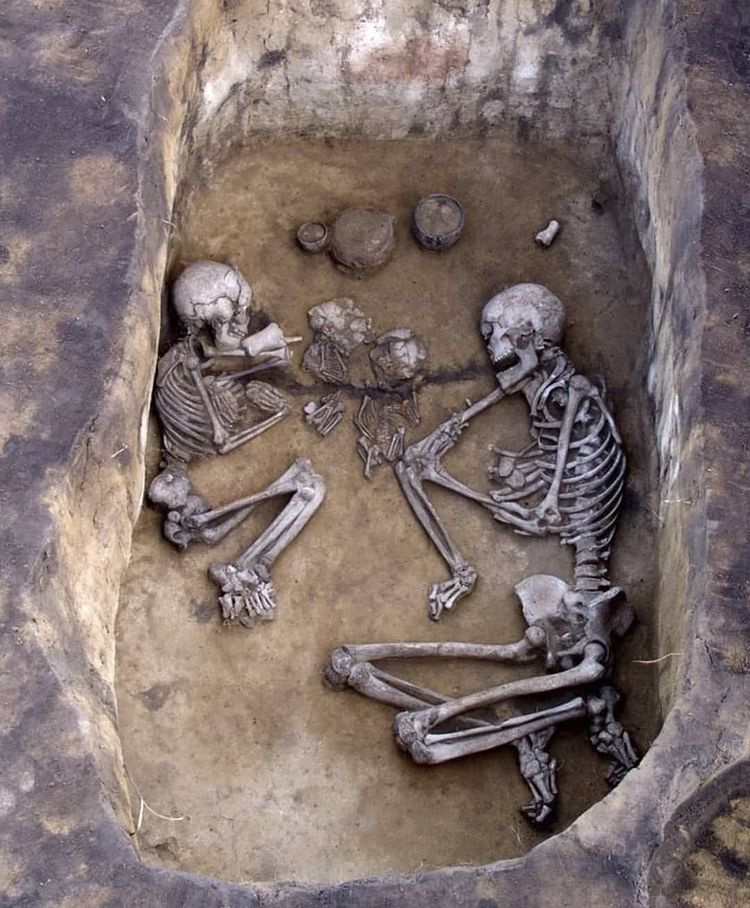Andronovo Culture (Kultura Andronowska)
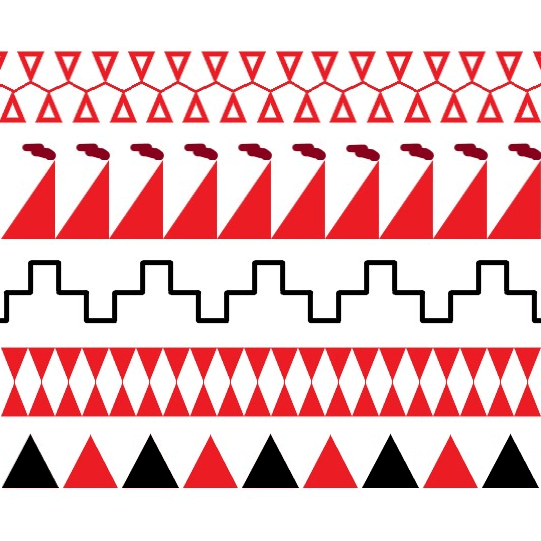
Kultura Andronowa Wzór odzieży dla kobiet w kulturze indoeuropejskiej Andronovo
tekst IE-C © © tłumaczenie Czesław Bialczyński

Andronovo Culture (Kultura Andronowska)
This culture existed from 2000 BC to 900 BC in Western Siberia and the central Eurasian Steppe. The older Sintashta Culture was its predecessor.
Kultura ta istniała od 2000 pne do 900 pne w zachodniej Syberii i na środkowym stepie euroazjatyckim. Jej poprzedniczką była starsza kultura Sintaszty.
Most researchers associate the Andronovo horizon with early Indo-Iranian languages, though it may have overlapped the early Uralic-speaking area at its Northern fringe.
Większość badaczy kojarzy horyzont Andronowa z wczesnymi językami indoirańskimi, chociaż mógł on nakładać się na wczesny obszar uralski na jego północnym krańcu.
According to a genetic study conducted by Allentoft et al. in 2015, the Andronovo Culture and the preceding Sintashta Culture are partially derived from the Corded Ware Culture, given the higher proportion of ancestry matching the earlier Neolithic Farmers from Europe, similar to the admixture found in the genomes of the Corded Ware population.
Według badania genetycznego przeprowadzonego przez Allentoft et al. w 2015 r. Kultura Andronowo i poprzedzająca ją kultura Sintashta wywodzą się częściowo z kultury ceramiki sznurowej, biorąc pod uwagę wyższy odsetek przodków odpowiadający wcześniejszym neolitycznym rolnikom z Europy, podobny do domieszki znalezionej w genomach populacji ceramiki sznurowej.
The Andronovo Culture consisted of both communities that were largely mobile as well as those settled in small villages. Fortifications include ditches, earthen banks as well as timber palisades, of which an estimated twenty have been discovered. Andronovo villages typically contain around two to twenty houses, but settlements containing as much as hundred houses have been discovered. Andronovo houses were generally constructed from pine, cedar, or birch, and were usually aligned overlooking the banks of rivers.
Kultura Andronowa składała się zarówno ze społeczności w dużej mierze mobilnych, jak i tych osiedlonych w małych wioskach. Wśród fortyfikacji znajdują się rowy, wały ziemne, a także drewniane palisady, których odkryto około dwudziestu. Wioski Andronowo zazwyczaj zawierają około dwóch do dwudziestu domów, ale odkryto osady zawierające nawet sto domów. Domy Kultury Andronowo były zazwyczaj budowane z sosny, cedru lub 🌳 brzozy i zwykle były ustawione z widokiem na brzegi 🏞️ rzek.
Andronovo livestock included cattle, horses, sheep, goats and camels. The domestic pig is notably absent, which is typical of a mobile economy. The percentage of cattle among Andronovo remains are significantly higher than among their Western Srubna neighbours. The horse was represented on Andronovo sites and was used for both riding and traction. Agriculture also played an important role in the Andronovo economy.
Inwentarz Andronowo obejmował 🐂 bydło, 🐎 konie, owce, kozy i 🐫 wielbłądy. Świnia domowa jest szczególnie nieobecna, co jest typowe dla gospodarki mobilnej. Odsetek bydła wśród szczątków kultury Andronowo jest znacznie wyższy niż wśród ich zachodnich sąsiadów Śrubna. Koń był reprezentowany w dziedzinach Andronowa i był używany zarówno do jazdy konnej, jak i do powożenia. Rolnictwo odgrywało również ważną rolę w gospodarce Andronowa.
The Andronovo culture is notable for regional advances in metallurgy. They mined deposits of copper ore in the Altai Mountains from around the 14th century BC. Bronze objects were numerous, and workshops existed for working copper.
🗡️ Kultura Andronowa wyróżnia się regionalnymi postępami w metalurgii. Wydobywali złoża rud miedzi w górach Ałtaj już w około XIV wieku p.n.e. Było wiele obiektów z brązu, istniały warsztaty do obróbki miedzi.
💀 The Andronovo dead were buried in timber or stone chambers under both round and rectangular kurgans (tumuli). Burials were accompanied by livestock, wheeled vehicles, cheek-pieces for horses, weapons, ceramics and ornaments. Among the most notable remains are the burials of chariots, dating from around 2000 BC and possibly earlier. The chariots are found with paired horse-teams, and the ritual burial of the horse in a „head and hooves” cult has also been found. Some Andronovo dead were buried in pairs, of adults or adult and a child. 💀
💀 Zmarłych w kulturze Andronowo chowano w drewnianych lub kamiennych komorach pod okrągłymi i prostokątnymi kurhanami (tumulusy). Pochówkom towarzyszyły zwierzęta gospodarskie, pojazdy kołowe, uzdy dla koni, broń, ceramika i ozdoby. Do najbardziej godnych uwagi pozostałości należą pochówki rydwanów, datowane na około 2000 r p.n.e. i prawdopodobnie wcześniejsze. Rydwany znajdują się w parach zaprzęgów konnych, znaleziono również rytualny pochówek konia w kulcie „głowa i kopyta”. Niektórzy zmarli „Andronowianie” zostali pochowani parami, dorośli lub dorosły i dziecko. 💀
Gallery Of Artifacts Galeria artefaktów
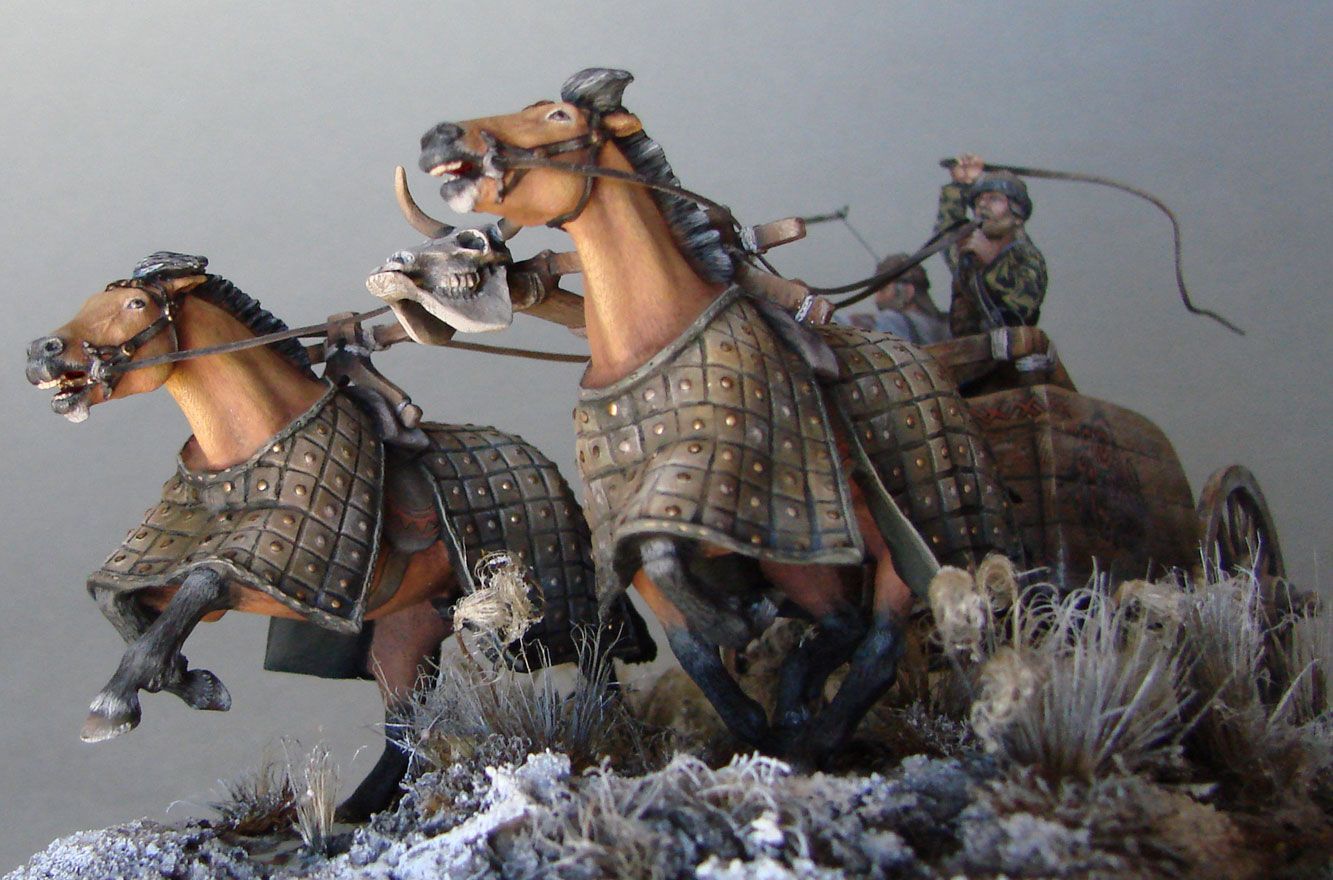
This is how a chariot from the Andronovo Culture might have looked like. It was pulled by the DOM2 type chestnut horses from Western Ukraine.
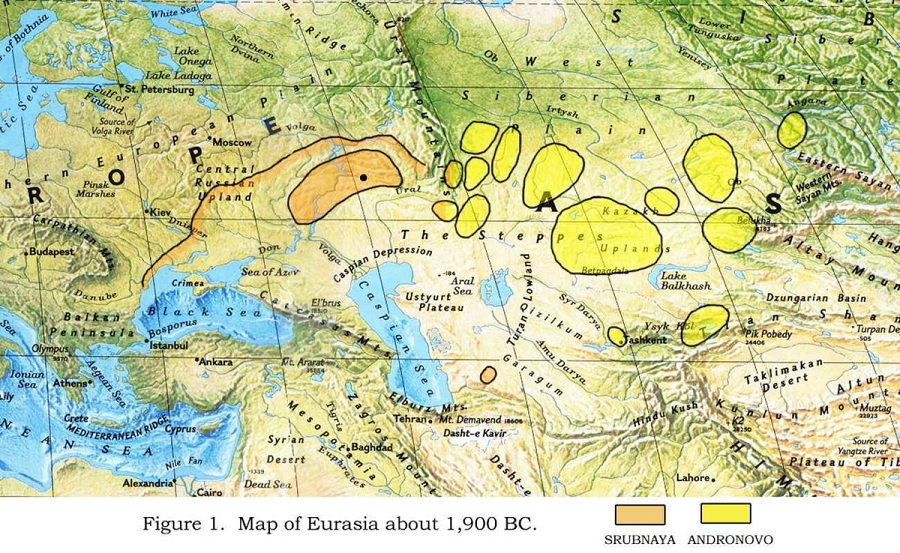
A map with marked archaeological sites from Srubna and Andronovo cultures.
Mapa ze znaleziskami archeologicznymi Kultury Andronowo i Śrubna
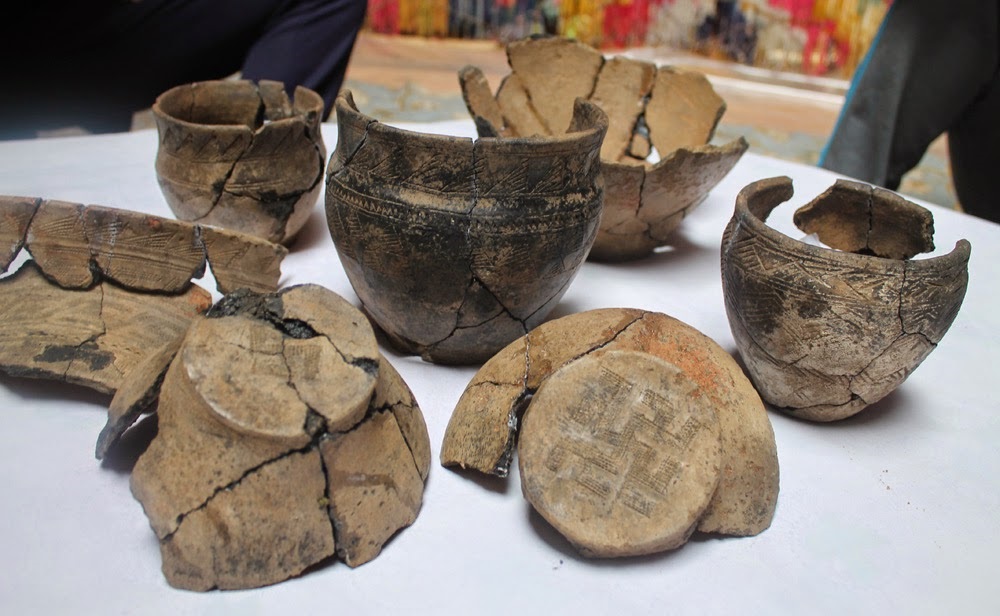
Samples of Andronovo Culture pottery
Przykłady ceramiki Andronowskiej
 More Andronovo pottery samples and bronze spears
More Andronovo pottery samples and bronze spears
Więcej okazów ceramiki i przedmioty z brązu
 A reconstruction of a burial with textiles from the Andronovo Culture site in Lisakovsk, Russia (by Emma Usmanova)
A reconstruction of a burial with textiles from the Andronovo Culture site in Lisakovsk, Russia (by Emma Usmanova)
Rekonstrukcja pochówku i ubioru Kultury Andronowo z okolicy Lisakowska w Rosji (wykonała Emma Usmanova)
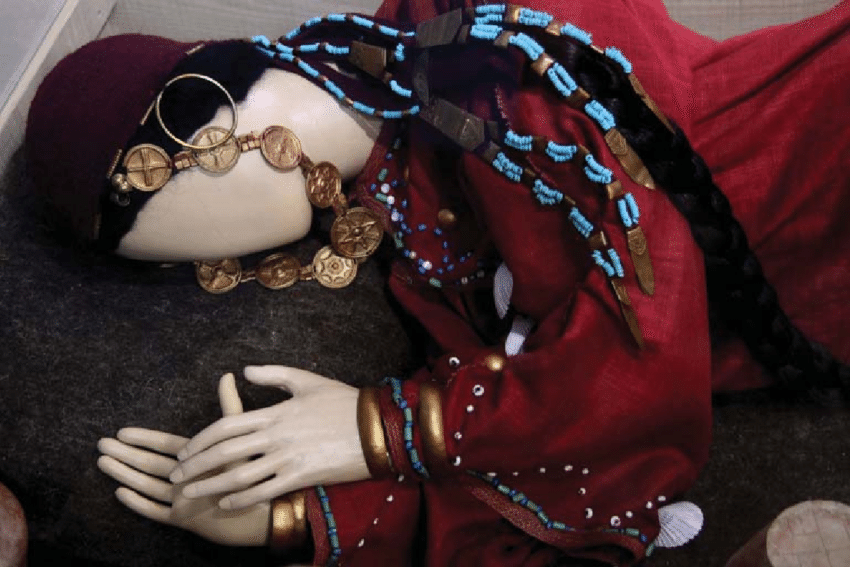
The detail of a headwear from Lisakovsk, Russia (by Emma Usmanova)
Szczegóły pochówku – strój i biżuteria, ułożenie ciała – Lisakowsk, Rosja (rekonstrukcja – Emma Usmanova)
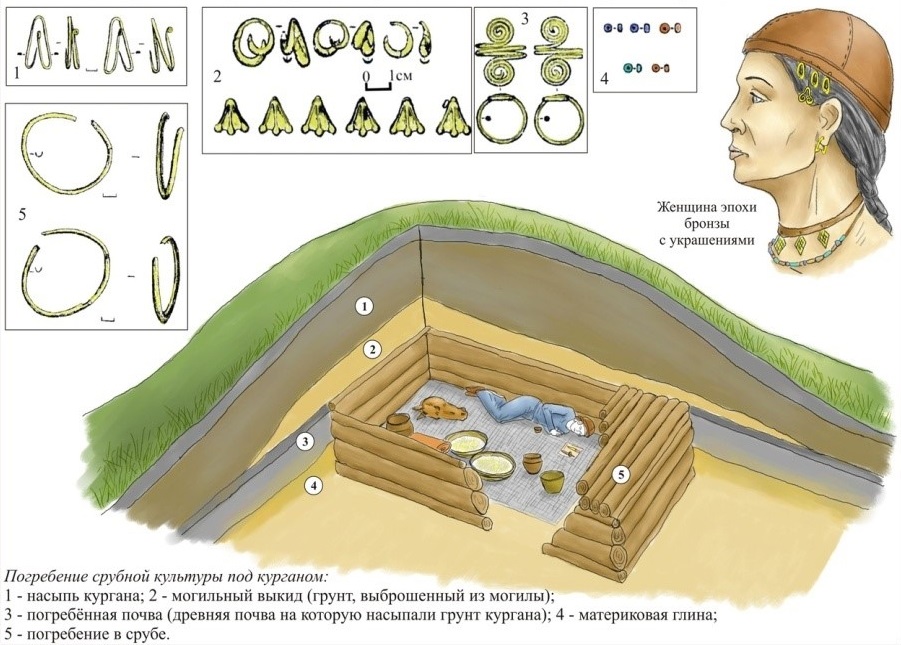
A kurgan burial with a wooden chamber from the neighbouring Srubna Culture. The Srubna Culture replaced the Yamna Culture after 1900 BC and bordered the Andronovo Culture on its Eastern fringes.
Grobowiec – kopiec-kurhan, z komorą drewnianą z sąsiedztwa kultury Andronowo – Kultura Śrubna. Kultura Śrubna zastąpiła Kultuirę Jamna po 1900 roku p.n.e. i graniczyła z Kulturą Andronowo od wschodu.
Grób kultury Andronowo z dwoma dorosłymi i dwójką małych dzieci z trzema naczyniami pogrzebowymi umieszczonymi nad ich głowami.
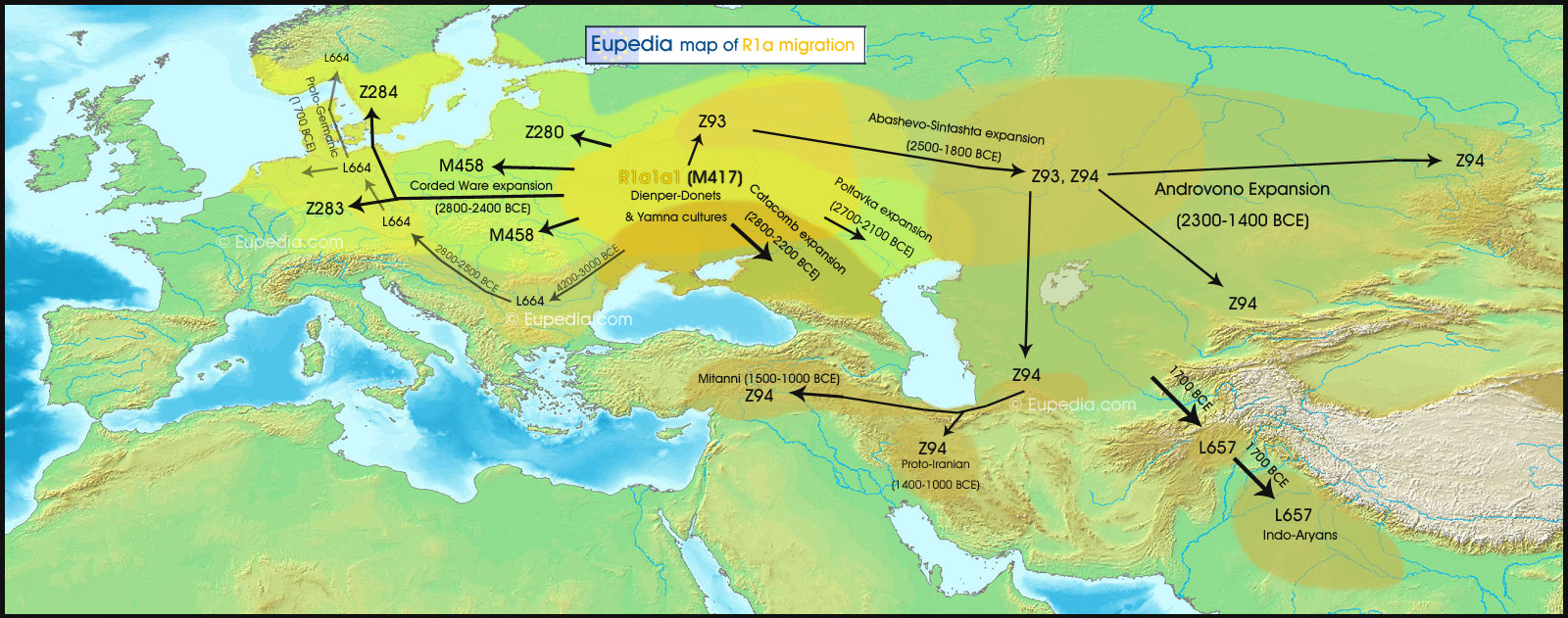 The expansion of R1a-Z93 and R1a-Z94 from the Fatyanovo-Balanovo Culture according to Eupedia
The expansion of R1a-Z93 and R1a-Z94 from the Fatyanovo-Balanovo Culture according to Eupedia
Ekspansja R1a Z93 i R1a – Z94 z kultury Fatianowo-Balanowo według Eupedii
DNA
Y-DNA extracted from one individual was determined to belong to haplogroup C (but not C3), while the other two extractions were determined to belong to haplogroup R1a1a, which is thought to mark the Eastward migration of the early Indo-Europeans. Of the individuals surveyed, only two (22%) were determined to be Mongoloid, while seven (78%) were determined to be Caucasoid, with the majority being light skinned with predominantly light-eyes and light-hair.
Y-DNA wyekstrahowane z jednego osobnika określono jako należące do haplogrupy C (ale nie C3), podczas gdy pozostałe dwie ekstrakcje określono jako należące do haplogrupy R1a1a, co uważa się, że oznacza migrację na wschód wczesnych Indoeuropejczyków. Spośród przebadanych osób tylko dwie (22%) zostały określone jako mongoloidalne, a siedem (78%) jako rasy kaukaskiej, przy czym większość była jasna, z przewagą jasnych oczu i jasnych włosów.
In June 2015 another genetic study surveyed one additional male of Andronovo Culture. Extraction of Y-DNA from this individual was determined to belong to R1a1a1b2a2 (R1a-Z93, clade R1a-Z2121). A 2018 study by Narasimhan et al examined genetic data from several individuals belonging to the Andronovo Culture. They were found to be genetically related to earlier Bronze Age populations of the Pontic-Caspian steppe (called by the authors Steppe_EMBA for Early-Middle Bronze Age). In addition, they harbored ancestry from European Middle Neolithic farmer populations. Narasimhan et al used the label Steppe_MLBA (Middle-Late Bronze Age) for this relatively homogeneous population spread across a vast region of Eastern Europe and Central Asia during 2000 BC – 1400 BC. Most male individuals examined belonged to the Y chromosome haplogroup R1a-Z645 (R1a-M417), especially its R1a-Z93 subclade.
W czerwcu 2015 inne badanie genetyczne obejmowało jednego dodatkowego mężczyznę z kultury Andronowo. Ustalono, że ekstrakcja Y-DNA z tego osobnika należy do R1a1a1b2a2 (R1a-Z93, klad R1a-Z2121). W badaniu przeprowadzonym w 2018 r. przez Narasimhana i wsp. zbadano dane genetyczne kilku osób należących do kultury Andronovo. Stwierdzono, że są one genetycznie spokrewnione z populacjami z wcześniejszej epoki brązu na stepie pontyjsko-kaspijskim (nazywanym przez autorów Steppe_EMBA od wczesnej i środkowej epoki brązu). Ponadto mieli przodków z europejskich populacji rolników z okresu środkowego neolitu. Narasimhan i wsp. użyli nazwy Steppe_MLBA (średnia i późna epoka brązu) dla tej stosunkowo jednorodnej populacji, która rozprzestrzeniła się na rozległym obszarze Europy Wschodniej i Azji Środkowej w latach 2000 BC – 1400 BC. Większość badanych osobników płci męskiej należała do haplogrupy chromosomu Y R1a-Z645 (R1a-M417), a zwłaszcza jej podkladu R1a-Z93. [podkreślenie CB – to ważne gdyż pokazuje wspólne źródło Z93 i populacji Słowian znad Wisły.]
Most of the Tarim Mummies from the neighbouring Xiahoe Culture (to the East of Andronovo Culture) belonged to the same R1a1a Y-DNA haplogroup (still without tested deeper subclades for R1a-Z93)[2]. A study from 2021 proved that the Tarim Mummies carried 72% of their autosomal DNA from the Ancient North Eurasian population just like the Eastern European Hunter-Gatherers did[3].
Większość mumii z Tarim z sąsiedniej kultury Xiahoe [CB Xiongnu – Toharów] (na wschód od kultury Andronovo) należała do tej samej haplogrupy R1a1a Y-DNA (wciąż bez testowanych głębszych podkladów dla R1a-Z93) [2]. Badanie z 2021 r. wykazało, że mumie z Tarim przeniosły 72% swojego autosomalnego DNA populacyjnego ze starożytnej północno-eurazjatyckiej populacji, podobnie jak to miało miejsce u łowców-zbieraczy z Europy Wschodniej[3].
The Allentoft et al. study from 2015 also confirmed that the Tarim mummies were genetically closer to people from the Andronovo Culture (Corded Ware and Fatyanovo-Balanovo descended) rather than to people from the Afanasievo Culture (purely Southern Yamna descended). Tarim Mummies from Xiaohe Culture carried a wide variety of maternal lineages (mtDNA), including West Eurasian lineages: H, K, U5, U7, U2e, T, R* (same as those found in the Corded Ware and Fatyanovo-Balanovo cultures) and East Eurasian lineages: B, C4, C5, D, G2a (ANE and Northern Siberia) and one Indian lineage: M5[4].
Allentoft i in. w badaniu z 2015 roku potwierdzili również, że mumie Tarimczyków były genetycznie bliższe ludziom z kultury Andronowo (potomkowie ceramiki sznurowej i Fatyanovo-Balanovo) niż ludzi z kultury Afanasievo (potomkowie czysto południowej Kultury Jamna). Mumie Tarimczyków z kultury Xiaohe nosiły szeroką gamę linii matczynych (mtDNA), w tym linie zachodnioeurazjatyckie: H, K, U5, U7, U2e, T, R* (takie same jak w kulturach Corded Ware – Ceramiki Sznurowej i Fatyanovo-Balanovo) i linia wschodnio euroazjatycka B, C4, C5, D, G2a (ANE i północna Syberia) oraz jedna indyjska linia genealogiczna: M5[4].
Rig Veda and Avesta – Rig Veda i Awesta
Comparisons between the archaeological evidence of the Andronovo and textual evidence of Indo-Iranians (the Vedas and the Avesta) are frequently made to support the Indo-Iranian identity of the Andronovo. The modern explanations for the Indo-Iranianization of Greater Iran and the Indian subcontinent rely heavily on the supposition that the Andronovo expanded Southwards into Central Asia or at least achieved linguistic dominance across the Bronze Age urban centres of the region, such as the Bactria–Margiana Archaeological Complex. While the earliest phases of the Andronovo culture are regarded as co-ordinate with the late period of Indo-Iranian linguistic unity, it is likely that in the later period they constituted a branch of the Iranians. This is also the ancestral culture of Scythians and Cimmerians.
Porównania między archeologicznymi dowodami Kultury Andronowo a tekstowymi dowodami Indo-Irańczyków (Wedy i Avesta) są często dokonywane w celu wsparcia indo-irańskiej tożsamości „Andronowian”. Współczesne wyjaśnienia indoiranianizacji Wielkiego Iranu i subkontynentu indyjskiego opierają się w dużej mierze na przypuszczeniu, że Andronowo rozszerzyło się na południe do Azji Środkowej lub przynajmniej osiągnęło dominację językową w ośrodkach miejskich z epoki brązu w regionie, takich jak Kompleks Archeologiczny – Baktria-Margiana. Podczas gdy najwcześniejsze fazy kultury Andronowo są uważane za zgodne z późnym okresem indo-irańskiej jedności językowej, jest prawdopodobne, że w późniejszym okresie stanowiły one gałąź Irańczyków. Taka jest również kultura przodków Scytów-Sokołotów i Kimerów.
Andronovo Culture used most of the words from the WORDS section because this culture is literally The Indo-European Connection.
Kultura Andronowo używała większości słów z sekcji SŁOWNIKA (https://www.indo-european-connection.com/words?page=1 ), ponieważ ta kultura to dosłownie Łącznik Indoeuropejski. [CB – Patrz Słownik gdzie znajduje sie bardzo wiele wspólnych słów – będziemy tłumaczyć ten słownik w przyszłości].
Artykuł zaktualizowany 29 października 2021 o nowe badania DNA.
Article updated on the 29th of October 2021 with new DNA studies.
Dziękujemy Autorowi blogu Indoeuropean Connection za wspaniałą pracę na rzecz upowszechnienia nowoczesnej nauki – o Starożytnym pochodzneiu Indo-Europejczyków, w tym Słowian i Bałtów. CB
We would like to thank the author of the blog Indoeuropean Connection for his wonderful work to popularize modern science – about the ancient origins of Indo-Europeans, including Slavs and Balts. CB
źródło: https://www.indo-european-connection.com/science/andronovo-culture

